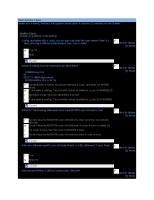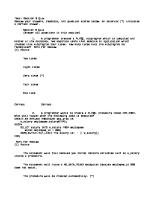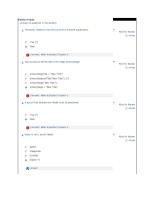Section 5 Quiz
Test: JFo Section 5 Quiz Review your answers, feedback, and question scores below. An asterisk (*) indicates a correct a
Views 727 Downloads 50 File size 66KB
Recommend stories
- Author / Uploaded
- Dede M Iskandar
Citation preview
Test: JFo Section 5 Quiz Review your answers, feedback, and question scores below. An asterisk (*) indicates a correct answer.
Section 5 Quiz (Answer all questions in this section)
1. The switch statement is a more efficient way to write code when dealing with a large range of unknown values. Mark for Review
(1) Points True False (*) Correct 2. What is the output? char grade = 'A'; switch (grade) { case 'A': System.out.println("Congratulations!"); case 'B': System.out.println("Good work"); case 'C': System.out.println("Average"); case 'D': System.out.println("Barely passing"); case 'F': System.out.println("Failed"); } Mark for Review
(1) Points A Congratulations! Good Work Average Barely Passing Failed (*) Congratulations! Failed Correct 3. Which two of the following data types can be used in a switch statement? Mark for Review
(1) Points float String(*)
int(*) boolean
Correct 4. What is the output? public static void main(String args[]) { char ch ='c'; switch(ch) { case 'a': case 'e': case 'i': case 'o': case 'u': System.out.println("Vowels"); break; default: System.out.println("Consonants"); } } Mark for Review
(1) Points Vowels Compilation error Vowels Consonants (*) Correct 5. What are the possible values of a boolean data type in Java? Mark for Review
(1) Points 0/1 good/bad true/false (*) yes/no Correct 6. Which three are conditional statements? Mark for Review
(1) Points switch statement(*) do while loop if/else statement(*)
if statement(*) for loop
Correct 7. What is the output? public static void main(String[] args) { String name = "Java"; String language = "Programming"; String fullName = name + language; boolean test = fullName.equals(name + language); System.out.println(test); } Mark for Review
(1) Points Java Programming JavaProgramming True (*) False Correct 8. The equal sign (=) is used to make an assignment, whereas the == sign merely makes a comparison and returns a boolean. Mark for Review
(1) Points True (*) False Correct 9. What is the output? public static void main(String[] args) { int age = 43; if (age == 43){ System.out.print("Bob is 43 "); } if (age == 50){ System.out.print("Bob is 50 "); } } Mark for Review
(1) Points No output
Bob is 43 (*) Bob is 50 Bob is 43 Bob is 50 Correct 10. How should Strings be compared? Mark for Review
(1) Points ~= The equals() method (*) == = Correct 11. A String comparison with == compares the Strings’ locations in memory and not the content of the String. Mark for Review
(1) Points True (*) False Correct 12. Which two are not logical operators? Mark for Review
(1) Points %(*) && ! || +(*)
Correct 13. In the AND (&&) test, if the first expression on the left hand side is false, then there is no need to evaluate the second statement. Mark for Review
(1) Points True (*) False Correct
14. What is the result? public static void main(String[] args) { int point = 10; String s = (point == 1 ? "point" : "points"); System.out.println("I scored " +point +" " +s ); } Mark for Review
(1) Points I scored 1 point Compilation error I scored 1 point 10 points I scored 10 points (*) Correct 15. In a boolean expression which uses the && operator, what would make this expression evaluate to true? boolean x = (firstCondition && secondCondition); Mark for Review
(1) Points If the first condition is true, but the second condition is false If both the first condition and second condition are false If both the first condition and second condition are true (*) If the first condition is false, but the second condition is true Correct









